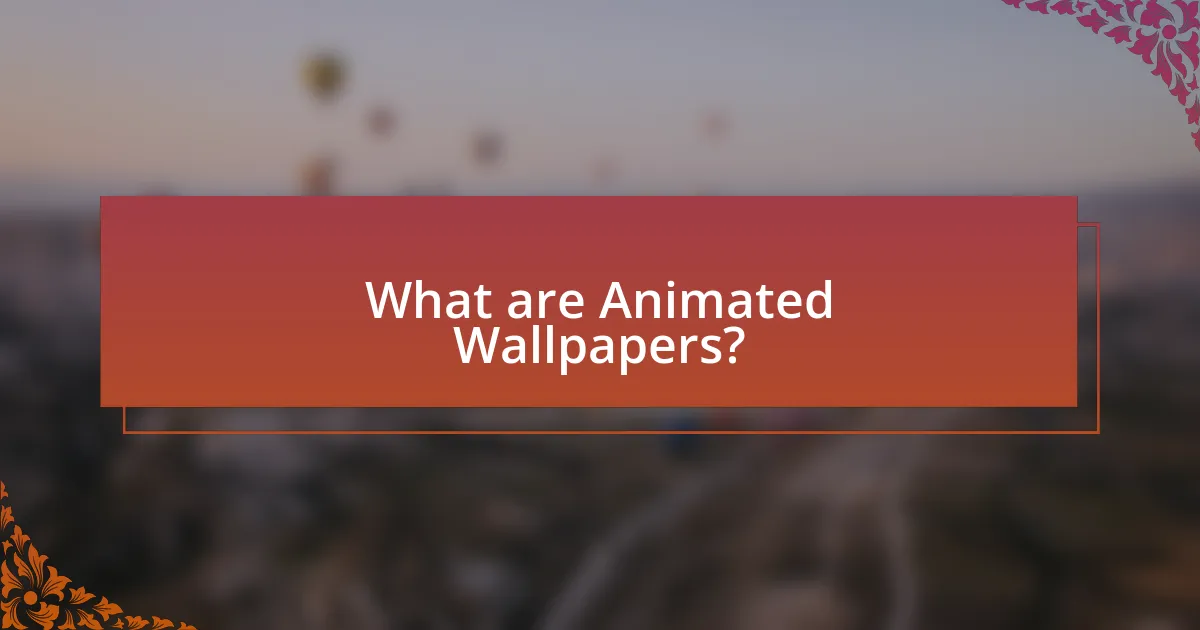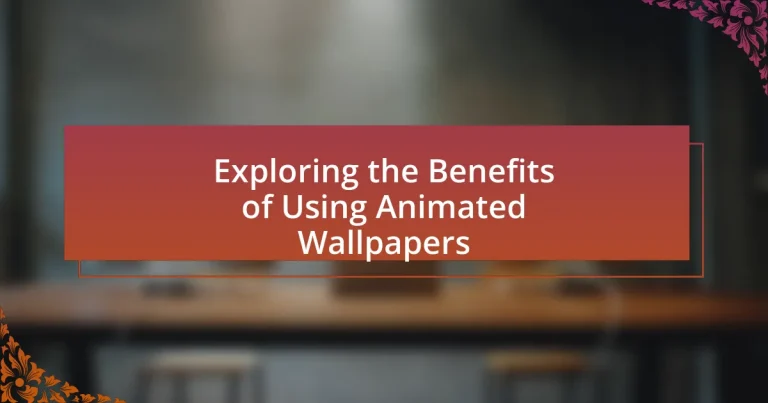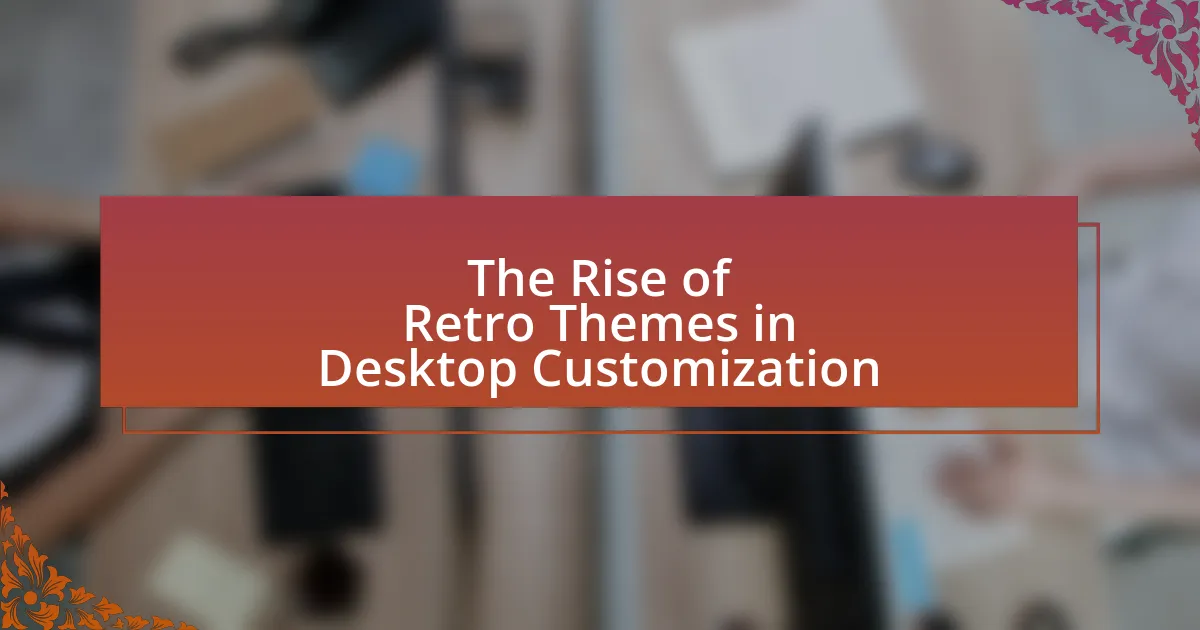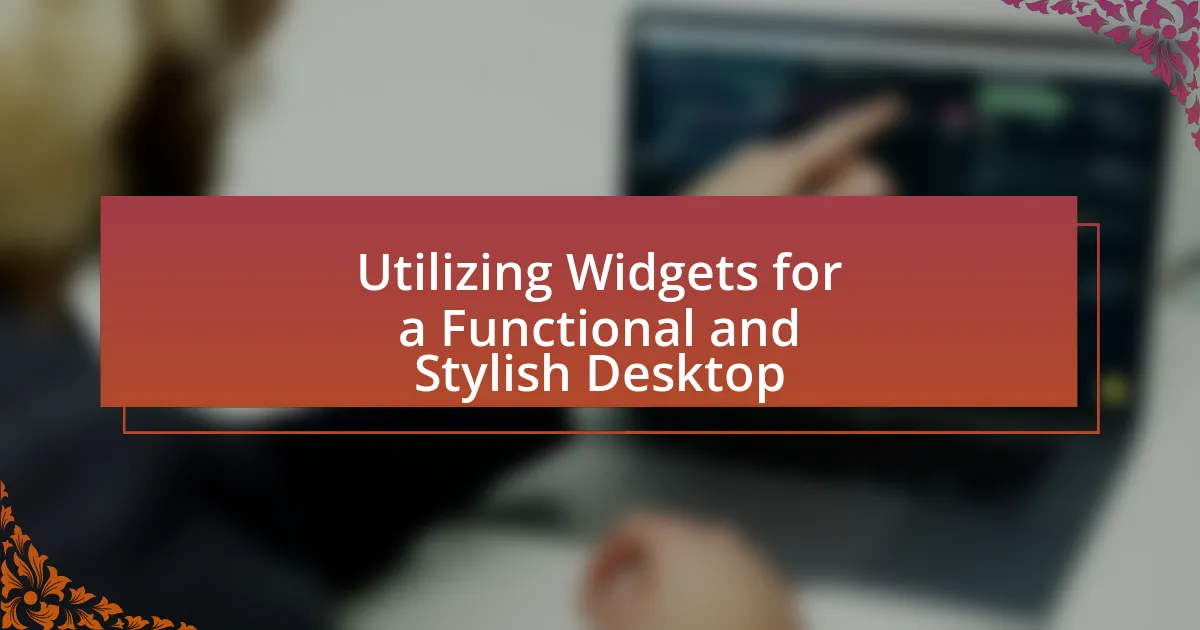Animated wallpapers are dynamic visual backgrounds that enhance the aesthetic appeal of devices by incorporating animations, videos, or interactive elements. This article explores the differences between animated and static wallpapers, the types of animations commonly used, and their impact on device performance. It also examines the growing popularity of animated wallpapers due to their ability to personalize user experiences, improve mood and productivity, and reflect individual styles. Additionally, considerations for selecting animated wallpapers, potential downsides, and tips for effective use are discussed, providing a comprehensive understanding of the benefits and challenges associated with animated wallpapers.

What are Animated Wallpapers?
Animated wallpapers are dynamic visual backgrounds that change over time, providing a more engaging and visually appealing experience compared to static wallpapers. These wallpapers can feature animations, videos, or interactive elements, enhancing the aesthetic of devices such as computers and smartphones. The use of animated wallpapers has been shown to increase user engagement and personalization, making devices feel more unique and tailored to individual preferences.
How do Animated Wallpapers differ from Static Wallpapers?
Animated wallpapers differ from static wallpapers primarily in their dynamic nature; animated wallpapers feature moving visuals, while static wallpapers consist of fixed images. This distinction allows animated wallpapers to create a more engaging and immersive user experience, as they can incorporate motion, transitions, and interactive elements that static wallpapers cannot provide. For instance, animated wallpapers can respond to user actions or change based on time of day, enhancing personalization and aesthetic appeal. In contrast, static wallpapers offer simplicity and lower resource consumption, making them suitable for devices with limited processing power.
What types of animations are commonly used in Animated Wallpapers?
Common types of animations used in animated wallpapers include looping animations, parallax effects, and particle animations. Looping animations create a continuous visual flow, often featuring elements like moving clouds or flowing water, which enhance the aesthetic appeal. Parallax effects provide a sense of depth by moving background layers at different speeds relative to the foreground, creating a three-dimensional feel. Particle animations involve small, dynamic elements like falling leaves or drifting snowflakes, adding a lively touch to the wallpaper. These animation types are popular due to their ability to engage viewers and create immersive environments on digital screens.
How do Animated Wallpapers impact device performance?
Animated wallpapers can significantly impact device performance by consuming more system resources compared to static wallpapers. The continuous motion and graphical complexity of animated wallpapers require additional CPU and GPU processing power, which can lead to increased battery drain and reduced overall performance, especially on lower-end devices. Studies have shown that devices with animated wallpapers may experience slower response times and decreased frame rates in applications due to the ongoing resource allocation for rendering the animations.
Why are Animated Wallpapers becoming popular?
Animated wallpapers are becoming popular due to their ability to enhance visual aesthetics and provide a dynamic user experience. Users are increasingly drawn to the engaging and immersive qualities that animated wallpapers offer, which can transform a static screen into a lively and personalized environment. According to a survey conducted by Statista in 2022, 65% of respondents indicated that visual appeal significantly influences their choice of digital backgrounds. This trend reflects a broader shift towards customization and personalization in digital interfaces, as users seek to express their individuality through unique visual elements.
What psychological effects do Animated Wallpapers have on users?
Animated wallpapers can enhance users’ mood and cognitive engagement. Research indicates that dynamic visuals can stimulate positive emotional responses, leading to increased creativity and focus. For instance, a study published in the journal “Computers in Human Behavior” found that visually appealing backgrounds can improve users’ productivity and satisfaction while working on tasks. Additionally, animated wallpapers can evoke nostalgia or joy, further contributing to a positive psychological state.
How do Animated Wallpapers enhance user experience?
Animated wallpapers enhance user experience by providing dynamic visual stimulation that engages users more effectively than static images. This engagement can lead to increased user satisfaction and enjoyment, as animated wallpapers often create a more immersive environment. Research indicates that visual elements significantly impact user interaction; for instance, a study published in the Journal of Usability Studies found that users reported higher levels of enjoyment and engagement when interacting with animated interfaces compared to static ones. Thus, animated wallpapers not only beautify the interface but also contribute to a more interactive and enjoyable user experience.

What are the Benefits of Using Animated Wallpapers?
Using animated wallpapers enhances user experience by providing dynamic visual stimulation and personalization options. Animated wallpapers can create an engaging atmosphere, making devices more visually appealing and enjoyable to use. Studies indicate that visually stimulating environments can improve mood and productivity, as seen in research published in the Journal of Environmental Psychology, which highlights the positive effects of aesthetic environments on emotional well-being. Additionally, animated wallpapers allow users to express their individuality, as they can choose designs that reflect their interests and preferences, further enhancing user satisfaction.
How do Animated Wallpapers improve aesthetic appeal?
Animated wallpapers enhance aesthetic appeal by introducing dynamic visuals that engage viewers and create a more immersive environment. Unlike static images, animated wallpapers can convey movement, color transitions, and thematic elements that capture attention and evoke emotions. Research indicates that visual stimuli, such as animations, can increase user satisfaction and engagement, making digital spaces feel more personalized and lively. For instance, studies have shown that environments with animated elements can lead to improved mood and creativity, reinforcing the idea that animated wallpapers significantly contribute to a more appealing and stimulating visual experience.
What role does color play in the effectiveness of Animated Wallpapers?
Color significantly influences the effectiveness of animated wallpapers by impacting viewer emotions and engagement. Research indicates that specific colors can evoke distinct psychological responses; for example, blue often promotes calmness, while red can stimulate excitement. This emotional response can enhance the overall user experience, making animated wallpapers more appealing and immersive. Additionally, studies show that color contrast can improve visibility and focus, which is crucial for maintaining user attention in dynamic visual environments. Therefore, the strategic use of color in animated wallpapers not only enhances aesthetic appeal but also plays a vital role in user interaction and satisfaction.
How can Animated Wallpapers reflect personal style?
Animated wallpapers can reflect personal style by allowing users to choose visuals that resonate with their interests, emotions, and aesthetics. These dynamic backgrounds can showcase themes such as nature, art, or technology, enabling individuals to express their unique preferences and personality traits. For instance, a person who enjoys serene landscapes may select a calming animated wallpaper featuring flowing water or gentle breezes, while someone with a passion for gaming might opt for vibrant animations related to their favorite titles. This customization not only enhances the visual appeal of devices but also creates an environment that aligns with the user’s identity and mood, reinforcing their personal style.
What practical advantages do Animated Wallpapers offer?
Animated wallpapers offer the practical advantage of enhancing visual appeal and user engagement on devices. They create a dynamic and immersive experience, making the interface more lively compared to static images. Studies indicate that animated elements can capture attention more effectively; for instance, a report by the Nielsen Norman Group highlights that users are drawn to motion, which can improve interaction rates. Additionally, animated wallpapers can reflect personal style and mood, allowing for greater customization and user satisfaction.
How can Animated Wallpapers be used for productivity enhancement?
Animated wallpapers can enhance productivity by providing visual stimulation that can improve focus and creativity. Research indicates that dynamic visuals can engage the brain more effectively than static images, leading to increased motivation and reduced fatigue during long work sessions. For instance, a study published in the Journal of Environmental Psychology found that environments with engaging visuals can boost cognitive performance and task engagement. By incorporating animated wallpapers that align with personal interests or work themes, individuals can create a more inspiring workspace, ultimately leading to improved productivity outcomes.
What are the benefits of using Animated Wallpapers for relaxation?
Animated wallpapers provide visual stimulation that can enhance relaxation by creating a calming atmosphere. The dynamic movement and soothing colors of animated wallpapers can distract from stressors and promote a sense of tranquility. Research indicates that visual stimuli, such as nature scenes or gentle animations, can lower heart rates and reduce anxiety levels, contributing to an overall feeling of well-being. Additionally, the personalization aspect of animated wallpapers allows users to curate their environment, which can further enhance comfort and relaxation.

What are the Considerations When Choosing Animated Wallpapers?
When choosing animated wallpapers, consider factors such as system performance, compatibility, and personal aesthetic preferences. System performance is crucial because animated wallpapers can consume more CPU and GPU resources than static images, potentially affecting device speed and battery life. Compatibility with the operating system ensures that the wallpaper functions correctly without causing glitches. Personal aesthetic preferences play a significant role, as users should select animations that resonate with their style and enhance their workspace or home environment.
How do you select the right Animated Wallpaper for your device?
To select the right animated wallpaper for your device, first consider the device’s specifications, including screen resolution and performance capabilities. High-resolution wallpapers enhance visual quality, while lower-performance devices may struggle with resource-intensive animations. Additionally, assess your personal aesthetic preferences and the mood you wish to convey, as animated wallpapers can range from calming nature scenes to dynamic abstract designs. Finally, ensure compatibility with your operating system and check user reviews for performance feedback, as this can provide insight into how well the wallpaper functions on similar devices.
What factors should be considered regarding file size and resolution?
When considering file size and resolution for animated wallpapers, the primary factors include the balance between visual quality and performance. Higher resolution images provide better clarity but result in larger file sizes, which can affect loading times and system performance. Conversely, lower resolution images reduce file size but may compromise visual fidelity. For instance, a 1920×1080 resolution wallpaper typically has a file size ranging from 1MB to 5MB, depending on the compression method used. Additionally, the device’s display capabilities and the intended use (e.g., desktop vs. mobile) should also influence the choice of resolution and file size to ensure optimal user experience without excessive resource consumption.
How can you ensure compatibility with your operating system?
To ensure compatibility with your operating system, verify that the animated wallpaper software explicitly lists support for your OS version. Many software developers provide detailed system requirements on their websites, indicating which operating systems are compatible, such as Windows, macOS, or Linux. For example, if you are using Windows 10, check that the animated wallpaper application specifies compatibility with Windows 10 to avoid installation issues. Additionally, reviewing user feedback and forums can provide insights into any compatibility problems experienced by others with similar setups.
What are the potential downsides of using Animated Wallpapers?
The potential downsides of using animated wallpapers include increased resource consumption, distraction, and compatibility issues. Animated wallpapers can significantly utilize CPU and GPU resources, leading to reduced performance on lower-end devices, as evidenced by studies showing that dynamic backgrounds can consume up to 30% more processing power compared to static images. Additionally, the movement and visual effects may distract users, impacting productivity, particularly in work or study environments. Lastly, some operating systems or devices may not support animated wallpapers, resulting in compatibility issues that can limit user experience.
How can Animated Wallpapers affect battery life?
Animated wallpapers can significantly affect battery life by consuming more power than static images. The continuous movement and rendering of graphics require additional processing power from the device’s CPU and GPU, leading to increased energy consumption. Studies have shown that devices using animated wallpapers can experience a battery drain of up to 20% more compared to those using static wallpapers, particularly on OLED screens where pixel illumination varies. This increased demand on hardware resources directly correlates with reduced battery efficiency and longevity during use.
What are the risks of using low-quality Animated Wallpapers?
Using low-quality animated wallpapers poses several risks, including decreased device performance, increased battery consumption, and potential security vulnerabilities. Low-resolution graphics can lead to lagging or freezing, negatively impacting user experience. Additionally, poorly optimized wallpapers may consume more processing power, resulting in faster battery drain. Furthermore, low-quality sources may contain malware or adware, compromising device security and user privacy. These factors highlight the importance of selecting high-quality animated wallpapers to ensure optimal device functionality and safety.
What are some tips for effectively using Animated Wallpapers?
To effectively use animated wallpapers, select wallpapers that complement your device’s performance and personal aesthetic. High-resolution animated wallpapers can enhance visual appeal but may consume more battery and processing power, so choose options that balance quality and resource usage. Additionally, consider the context in which the wallpaper will be used; for example, a calming animated wallpaper may be suitable for a work environment, while a vibrant one could enhance a gaming setup. Regularly updating your animated wallpapers can keep your device feeling fresh and engaging, as studies show that visual variety can improve user satisfaction and engagement.




